![]()
What Is Your Niche?What Is Your Niche?
Niche MarketingNiche Marketing
by Dan Kennedy
There are riches in niches for your small-business marketing.
The first official international convention of The Almagamated Order of Real Bearded Santas was held in Branson, Missouri, attended by over 300 professional Santas with real beards (a niche within the Santa niche!), plus some Mrs. Santas and a few nebbishy elves horning in on the fun.
I was at a National Speakers Association Convention in the late ’70s not much bigger than this. Now NSA has 5,000+ members and is the trade association of that industry.
And, with local chapters around the world, and more getting going, GKIC is an international association of a size to be reckoned with.
EACH of these associations and all others (there are thousands) represent a lucrative niche market for somebody.
After he failed to gain the support of his employer, James Perez-Foster, a former partner at Bainbridge Advisors, left his job to focus on the Hispanic market. He saw an underserved market with a lot of potential and wanted to focus on this target market.
He started Solera National Bank, which is dedicated to serving Colorado’s growing population of Hispanic and minority-owned businesses. According to an article in Forbes, Perez-Foster says, “Banks are sitting on the precipice of an enormous wave of minority-owned, small to mid-sized businesses with upwards of $75 billion in annual capital demands to fuel and scale business growth, and the U.S. Hispanic and women-owned small businesses are the fastest growing small-business segments in the U.S. economy.” For the most part, Hispanic business owners—just like any household, Hispanic or otherwise, with at least $100,000 in income—have two key goals: “Retiring with financial dignity and affording to send their children to college,” he says.
According to a study done by ShareThis, U.S. Latinos are
• five times more likely to share content vs. nonHispanics,
• twice as likely to click on shared content vs. nonHipsanics,
• twice as likely to purchase the products they share vs. nonHispanics, and
• have four times the brand loyalty of nonHispanics.
The point: In EVERY market/business there are specialty opportunities. Find yours.
When Choosing an Audience: Better to Pick a Small Haystack and More Needles than a Big Haystack with Hardly any Needles
We all know the “needle in the haystack” metaphor. The idea here is it’s better to choose a small, well-defined niche and have a ton of followers in that small niche than pick a large niche where your message won’t be heard.
HOW TO USE THIS IN YOUR OWN BUSINESS
If you already have chosen a niche (whether large or small), you can carve out an even smaller niche for yourself through specialization.
You can do this simply by redefining what it is you do and finding a smaller group of people who are seeking those specialty services. Experts within their space are constantly redefining themselves to serve a smaller, more defined niche—“a smaller haystack.”
To define this special space and create that unique niche, you just need to ask yourself a few simple questions:
1. Who? Who is the specific buyer or person you are trying to reach? Get to know them, define them, and understand their behaviors.
2. Why? Why is this important? Why are you doing this?
3. Needs/Benefits? What need are you fulfilling? What does that customer want from you and what problem will be solved?
And finally, target a very specific niche market to start with. Finding and selecting a specialized target market is a safer and better bet than targeting the masses when starting out.
Look at it this way. If you want to sell your product or service to the general public, you need a substantial marketing budget because you’ll need to run ads in major publications, do massive direct-mail campaigns, and spend larger amounts on internet advertising.
Why not hitch your wagon to a smaller niche market so you can really start to make hay?
Be a Magnet to Your Target CustomersBe a Magnet to Your Target Customers
by Kim Walsh-Phillips
Kari Voutilainen only sold 50 of his products in 2014. And he was satisfied with that.
Voutilainen is a Finnish watchmaker who specialized in a Vingt-8 wristwatch, a platinum G.M.T. (Greenwich Mean Time) model with hand-fabricated movement. The watches go for about $86,000 each.
Voutilainen doesn’t try to create products for everyone. He has a niche that he focuses on diligently. His V-8R watch won the Men’s Watch Prize in the esteemed Grand Prix d’Horlogerie competition.
When asked if he was going to limit production if the market decreases, he said, “Even if there is a 10% decrease in interest, that means only five buyers for me. I can go out and find five more people to buy these watches.”
50 products, $4.3 million in revenue.
Not bad.
Set Yourself Up for Success
Knowing who you are is important. I used to present my company as a “full-service marketing agency.” But really, what does that even mean?
For me, it meant a lot of angst.
With no focus or niche, we attracted every type of local small business that needed help. They usually had no marketing funnel set up, no list to work with, and no budget. We attracted a LOT of businesses like this.
These small businesses were awful at paying, so even when my contracts were close to covering expenses, we couldn’t pay our bills. The most important time each day was 3 P.M. because that was when a deposit had to reach the bank to count for that day. Our mail carrier had to arrive before 3 P.M. and there needed to be a check in there so we could get in before 3 P.M., or something would fall apart. Our internet might be shut down. A vendor paramount to a marketing firm, like a printer, might cut us off (rightfully so) or worse, I would risk not being able to make payroll.
Some days the mail carrier came before 3 P.M. And some days she didn’t. As I think back on it, she usually didn’t. We had a very slow mail carrier in those years who would use my office building to hide out and take an extended break BEFORE delivering the mail. I tried using my Italian death stare, but even that didn’t work.
Being all things to everyone means never being able to choose your customers or business growth. You have no control over the future of your company if you try to attract everyone.
Narrow your focus.
Targeting your audience to as small a group as possible allows you to offer content that is valuable to that group so you can build a strong relationship and increase your chances of brand conversion.
It is much better to have 500 raving fans than 10,000 tepid followers. You want to attract and engage exactly the type of person who will pay you what you are worth. Remember . . .
SOMEONE ALREADY HAS THE MONEY THAT WILL BE YOUR NEXT SALE
Your job is to figure out who and why they will give it to you.
• Look at the top 10% of your customers by revenue or, better yet, by profit.
• Make a list of these customers and look for trends.
• Run the “whose vacation do you want to go on?” test. Think about all of your customers and if they invited you on vacation with them or to a conference they were going to and there were going to be thousands of people just like him or her there, whose conference would you want to go to?
I come from the belief that as long as you are going to work really hard at growing your business, you might as well enjoy it. Whoever you picture can be your niche. As long as you are profitable with this target market and enjoy working with them, then you have found your niche.
And you can create the business you really want.
Unlike most financial planners, Pamela Yellen makes Wall Street the “enemy” in her marketing. She knows her market is made up of independent thinkers who want to control their own future. She does well with Christian Conservatives who are married, educated, and financially well off.
She doesn’t hide her political views or thoughts on investing. She shares intentionally, and those who follow her know that.
Once You Determine the “Who,” You Are Just Getting Started
Before you start to deliver you message in any medium, you must know who your market is.
It is imperative that you develop your perfect prospect “avatar.” This is everything about your key perfect customers who you want to flood into your business.
Things to focus on when creating your avatar: sex, age, profession, marital status, sexual orientation, location, native language, education, income, technological expertise, and family composition. Equally important to discover are their media-buying habits, interests, frustrations, and other favorite brand pages. All of this research goes into the strategy behind our current clients’ work.
And sometimes you can find golden nuggets. Facebook gives you the ability to discover a lot of this information through its Ads Manager.
We uploaded the membership list of one of our clients, a major marketing organization, and here is some of the data Facebook Insights told us:
1. Its customers are married and college educated, with many having attended graduate school. All rank higher than the average Facebook user (see Figure 5.1).
FIGURE 5.1: Relationship Status vs. Education Level
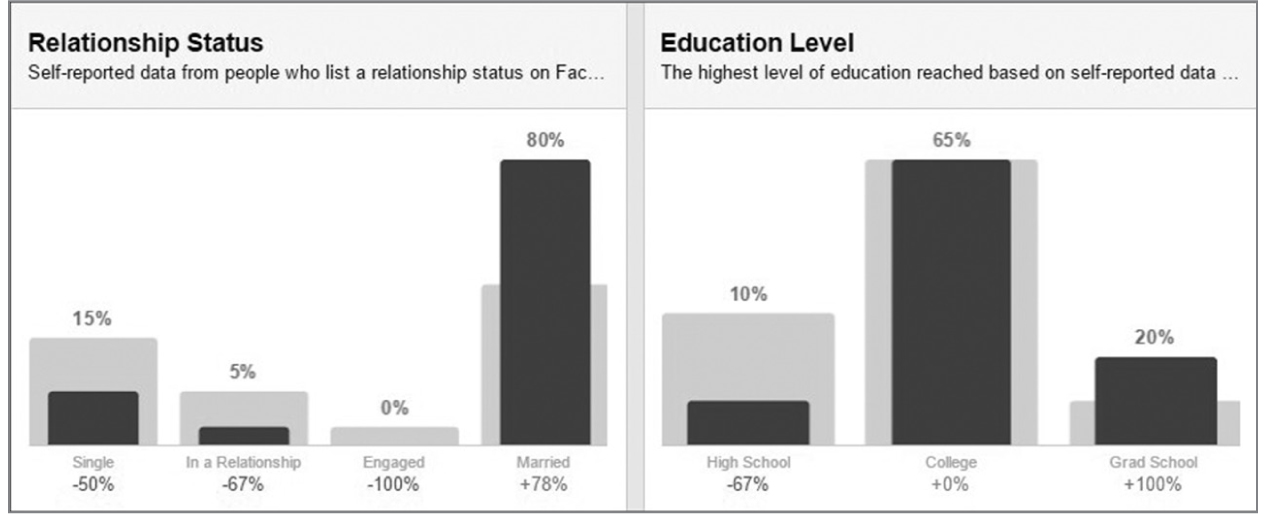
2. Most use desktop and mobile, but a quarter use desktop only. This is signifigantly higher than the average Facebook user and a positive when trying to market online—because this company’s ideal prospects are more likely to be looking at their messaging on a larger screen. Only 5% are mobile-only users, which is 86% less than the average Facebook user (see Figure 5.2 on page 60).
3. They spend less money online than the average Facebook user (see Figure 5.3 on page 60). Only 45% ranks medium to high in online spending. Most would assume you should ignore those who don’t spend online. These metrics say something different entirely.
4. Its buyers are more likely to make business purchases and to take on subscription services (see Figure 5.4 on page 61).
FIGURE 5.2: Device Users
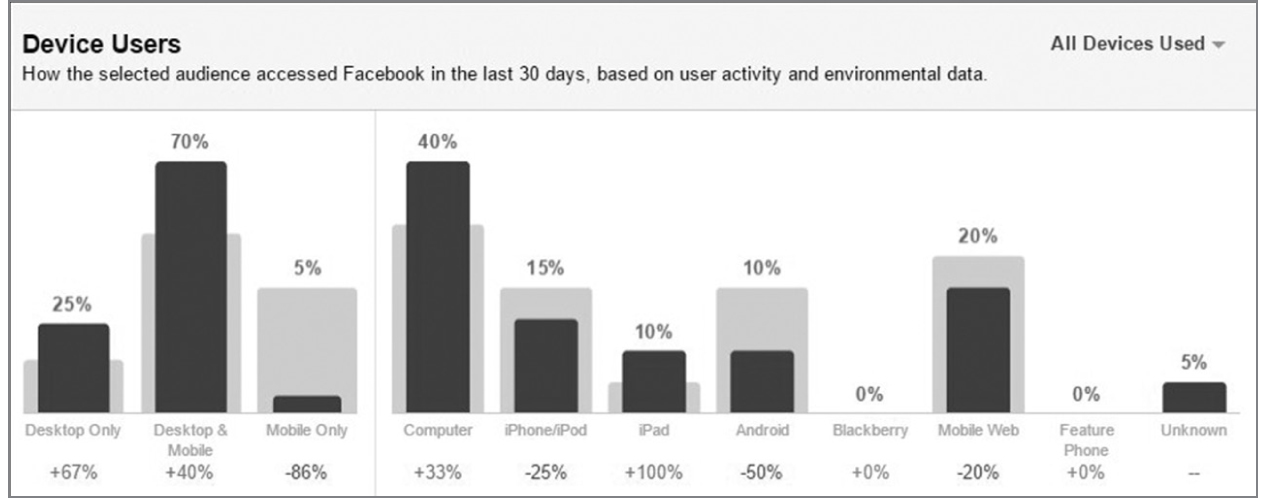
FIGURE 5.3: Online Purchases
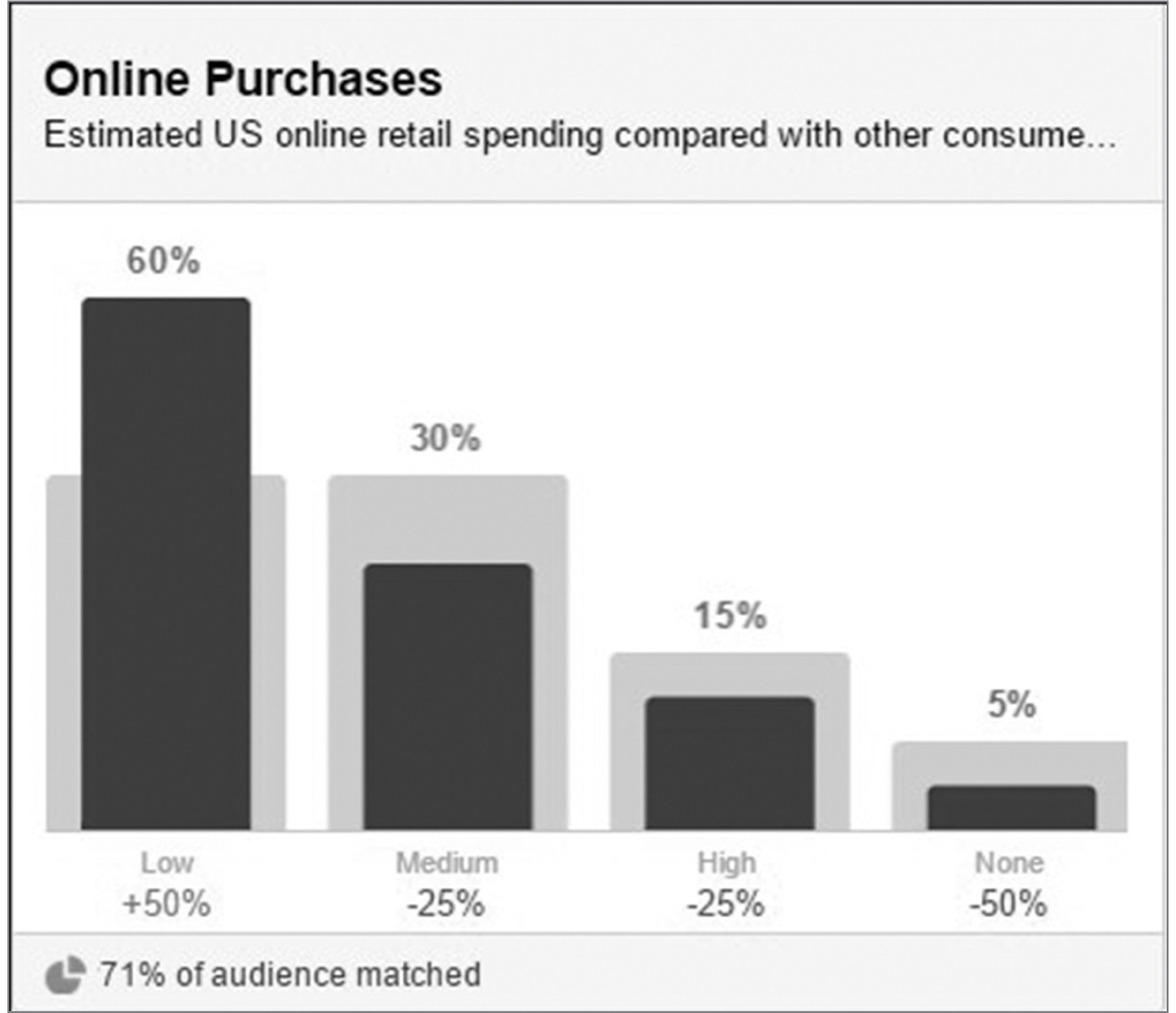
5. They own their home (see Figure 5.5 on page 61).
FIGURE 5.4: Purchase Behavior
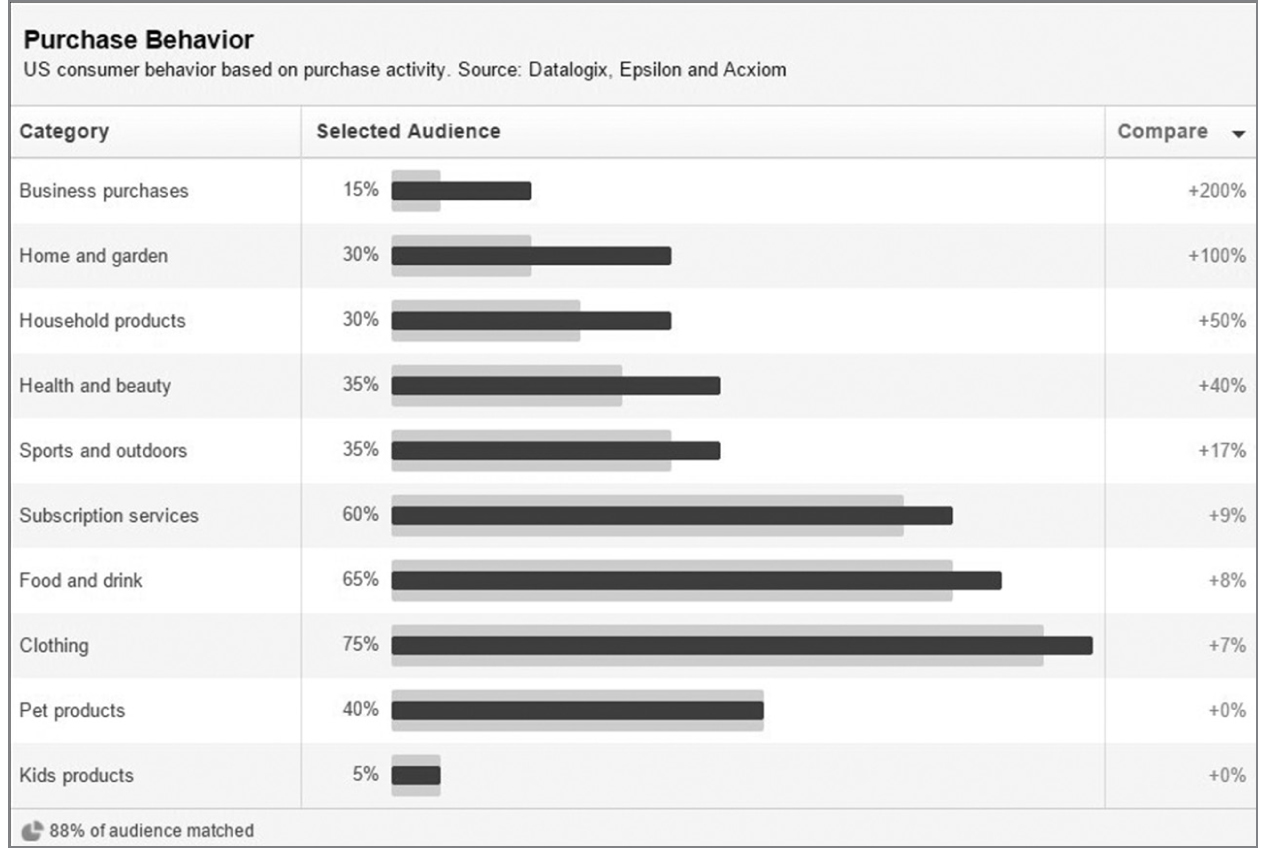
FIGURE 5.5: Home Ownership
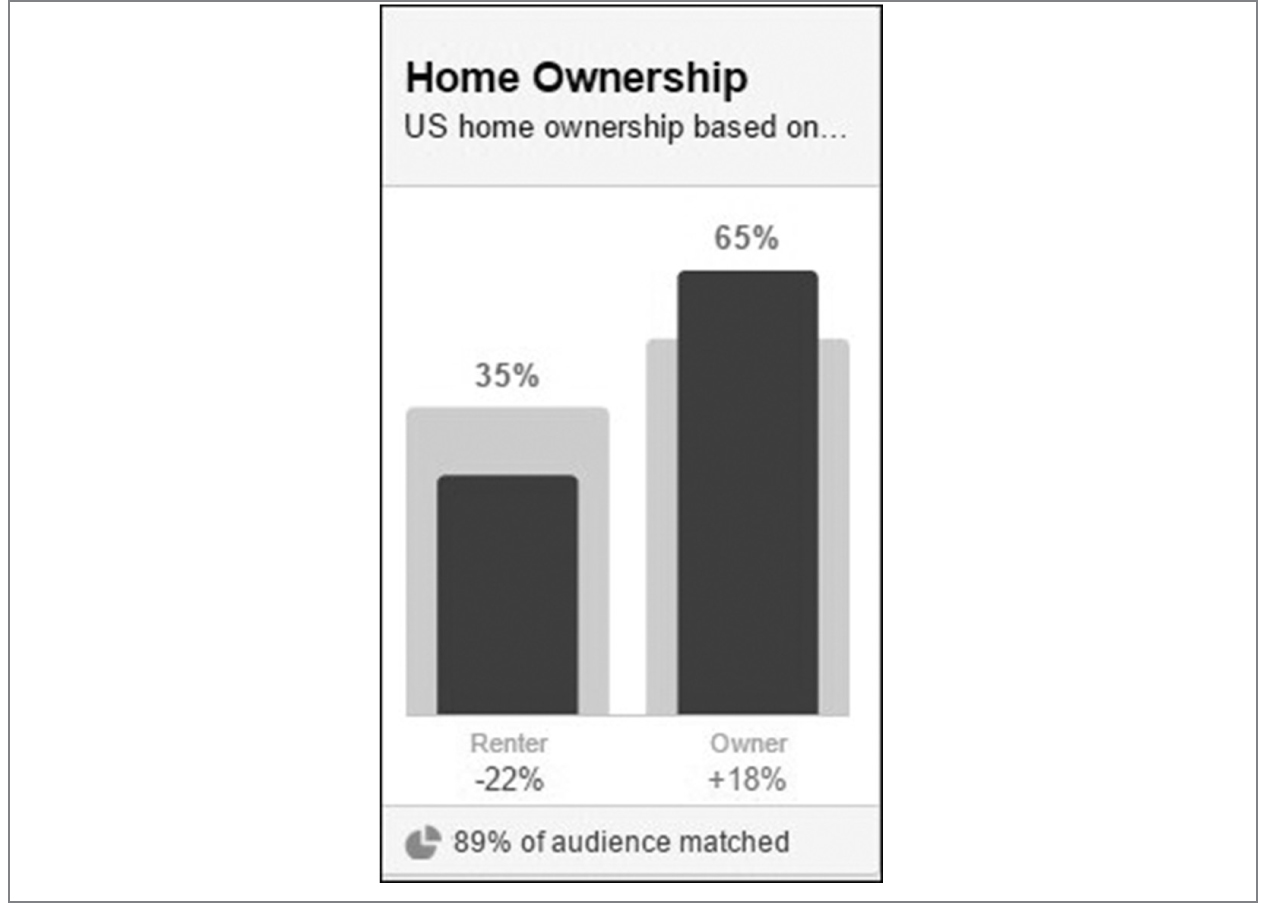
6. They primarily put everything on a credit card, with 20% having a travel credit card and 30% a premium credit card (see Figure 5.6).
FIGURE 5.6: Spending Methods
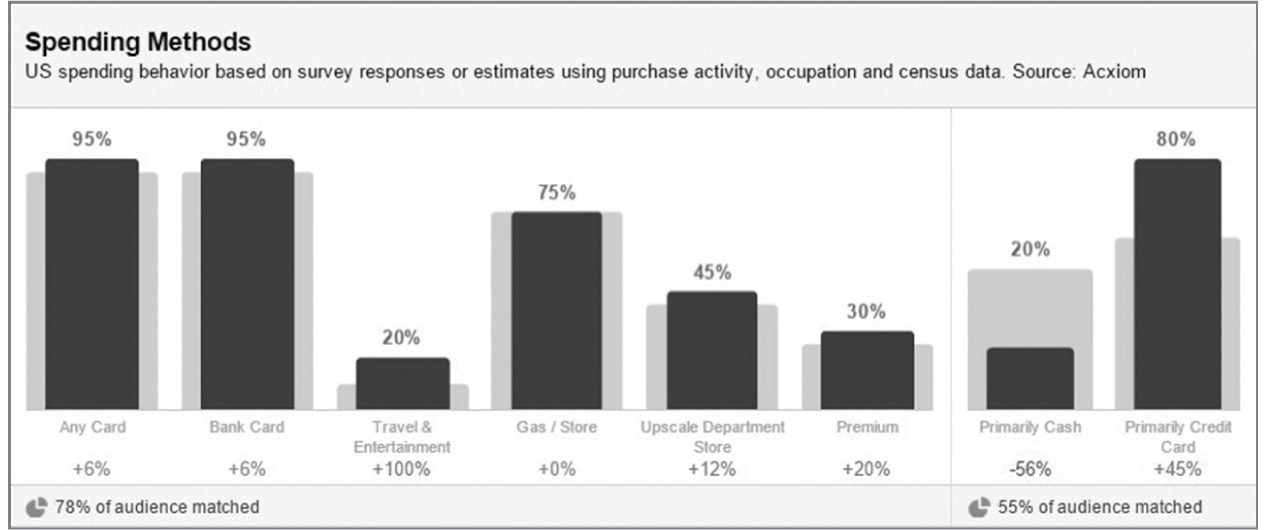
7. In looking at their Lifestyle Cluster, 15% of them are “Summit Estate Families” (see Figure 5.7).
FIGURE 5.7: Lifestyle
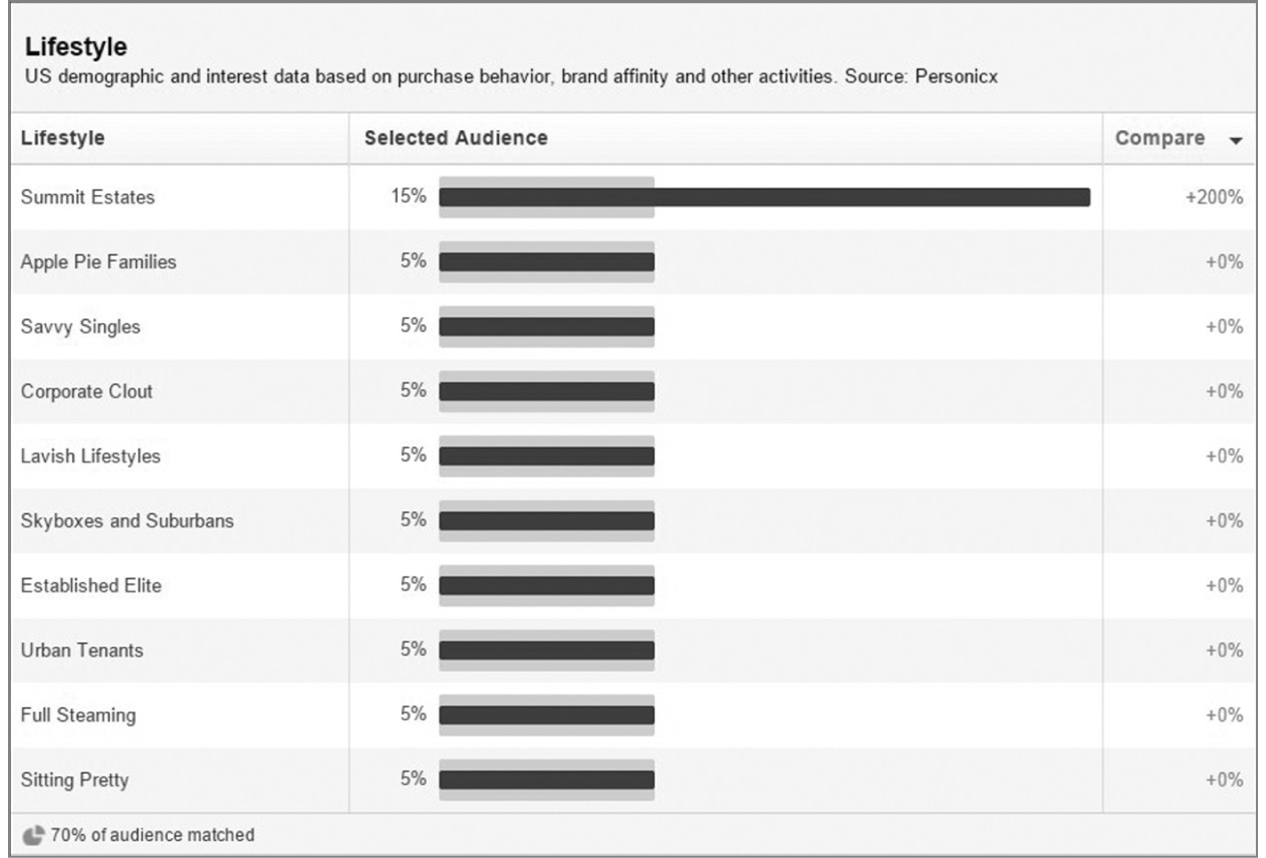
“Summit Estate” families are enjoying the good life—luxury travel, entertainment, and consumption of every kind are within easy reach.
The above information is drawn from Acxiom, the data mining company behind segmentation software “Perspectives.” Just think about the Established Elite. They mostly come from segments defined as Active Lifestyle, Corporate Connections, Top Professionals, and Active. How much more effective can your messaging be with this information? You can speak directly to your best target customers to attract more of them and ignore everyone else. Not only will this bring you more ideal customers, but it will save you money as there is no reason to focus on the masses.
The key thing is that this is an analysis of its customers’ data, not its list of people who simply opted in and never bought anything. If you take a look at those stats, the picture is much different.
For a website traffic breakdown, see Figure 5.8.
FIGURE 5.8: Website Traffic Breakdown
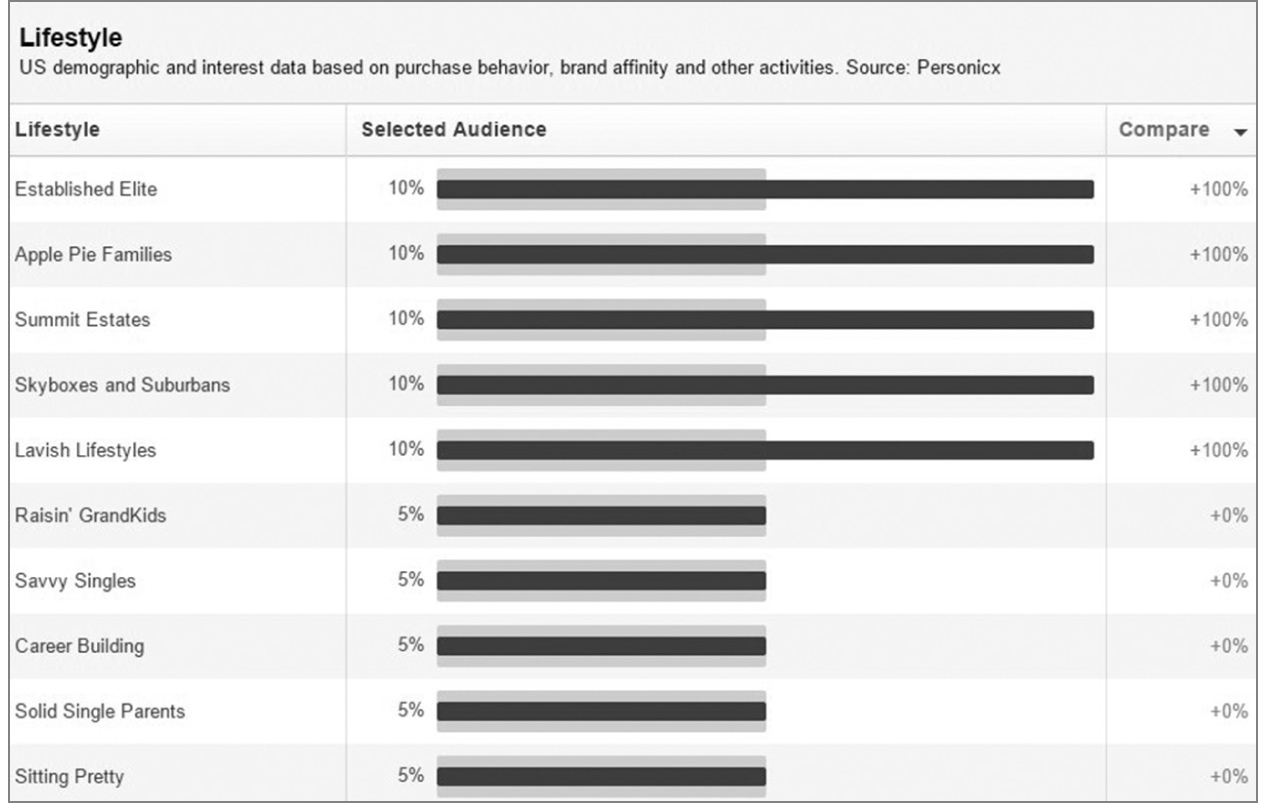
Several profiles rank higher than average (see Figure 5.9).
FIGURE 5.9: Profile Ranking—Online Purchases
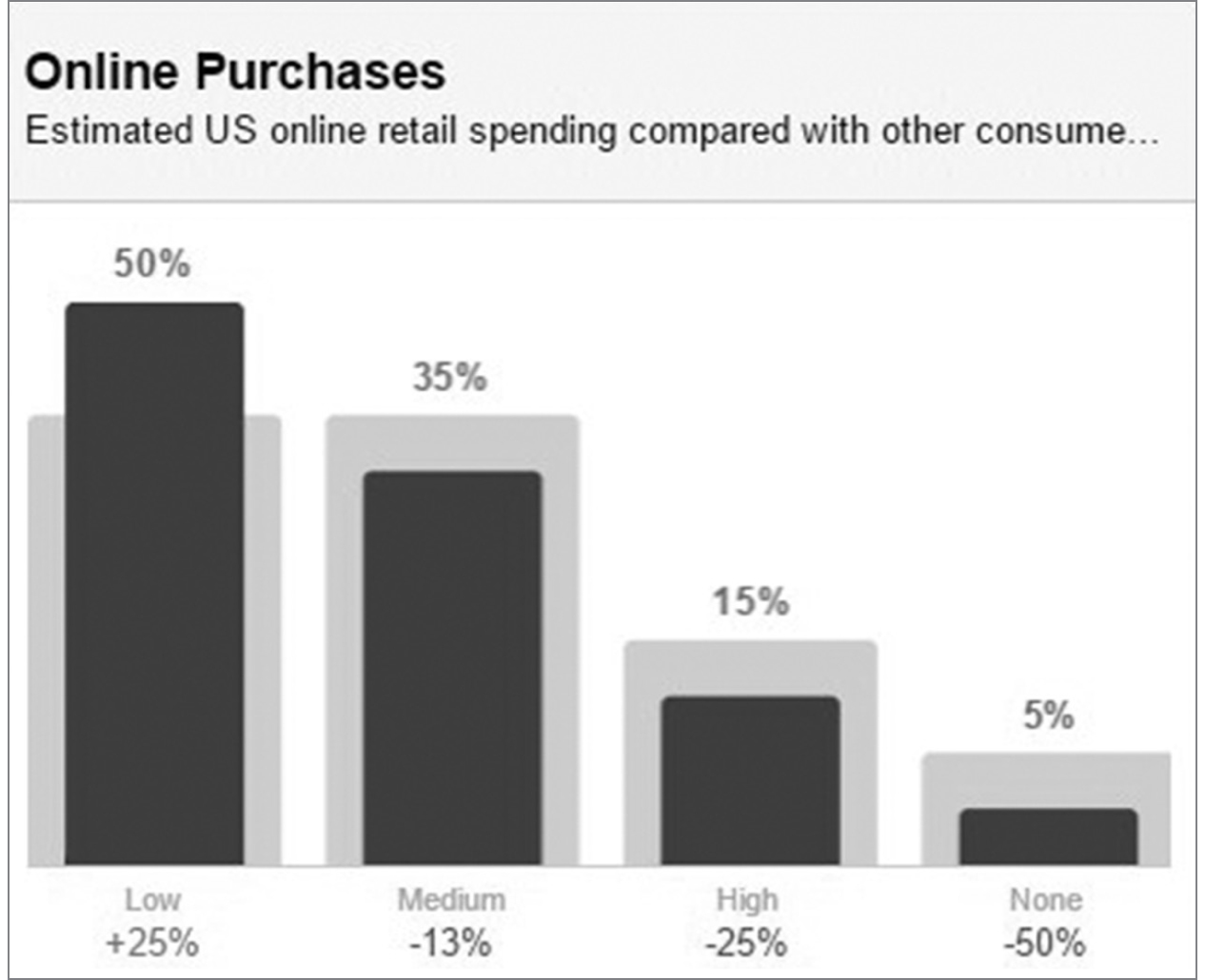
More people make online purchases (see Figure 5.10 on page 65).
Subscription services are no higher than average compared to their fans (see Figure 5.11 on page 65).
Online spending is fairly average with slightly fewer people purchasing this way (see Figure 5.12 on page 66).
Subscription services are not dramatically higher than the average (see Figure 5.13 on page 66).
No one type of interest and demographic stands out.
Clearly, when creating a “Look Alike” audience, it should focus on its best customers to get more like them, those who typically do not spend money online but do spend money on subscription services.
FIGURE 5.10: Purchase Behavior—Online Purchases
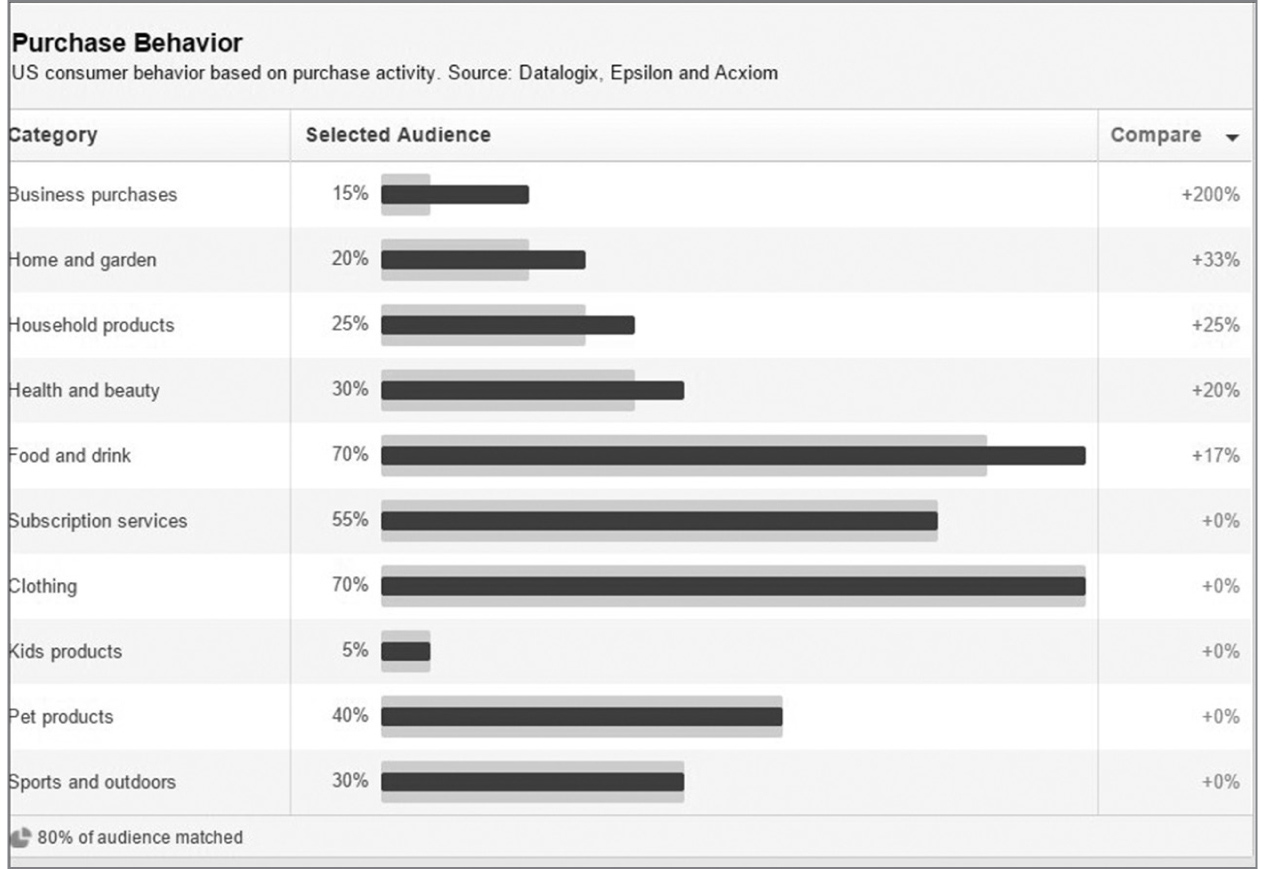
FIGURE 5.11: Online Purchases—Fans
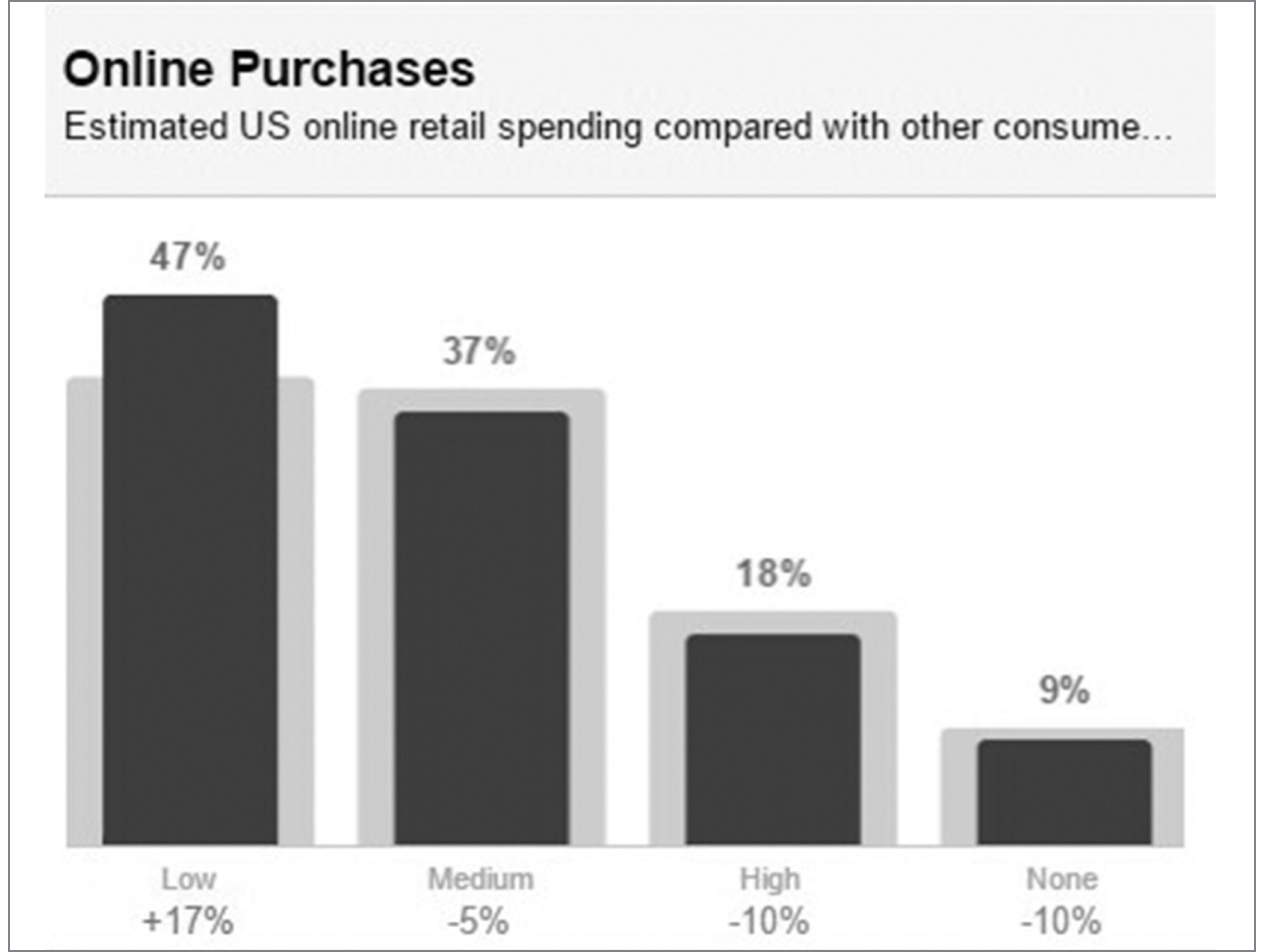
FIGURE 5.12: Purchase Behavior—Online Spending
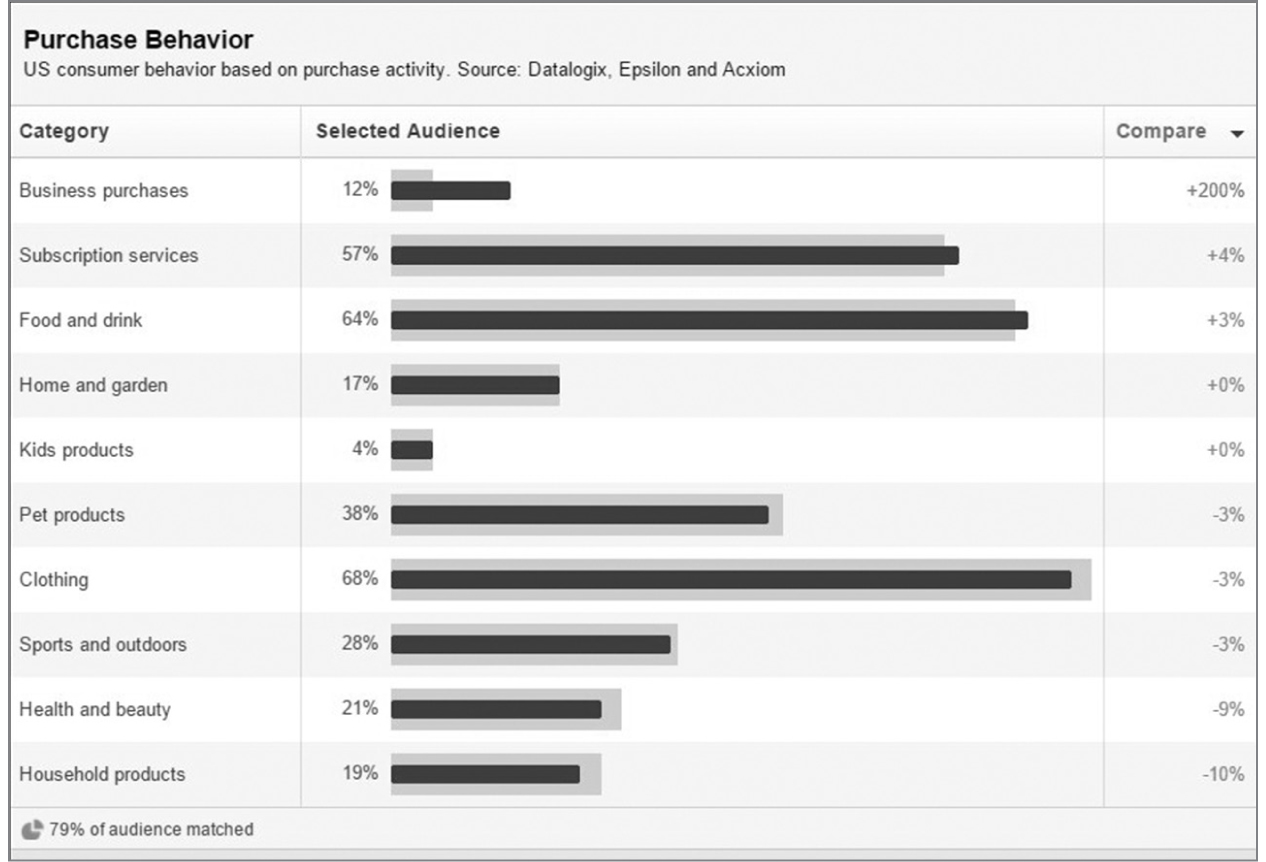
FIGURE 5.13: Subscription Services
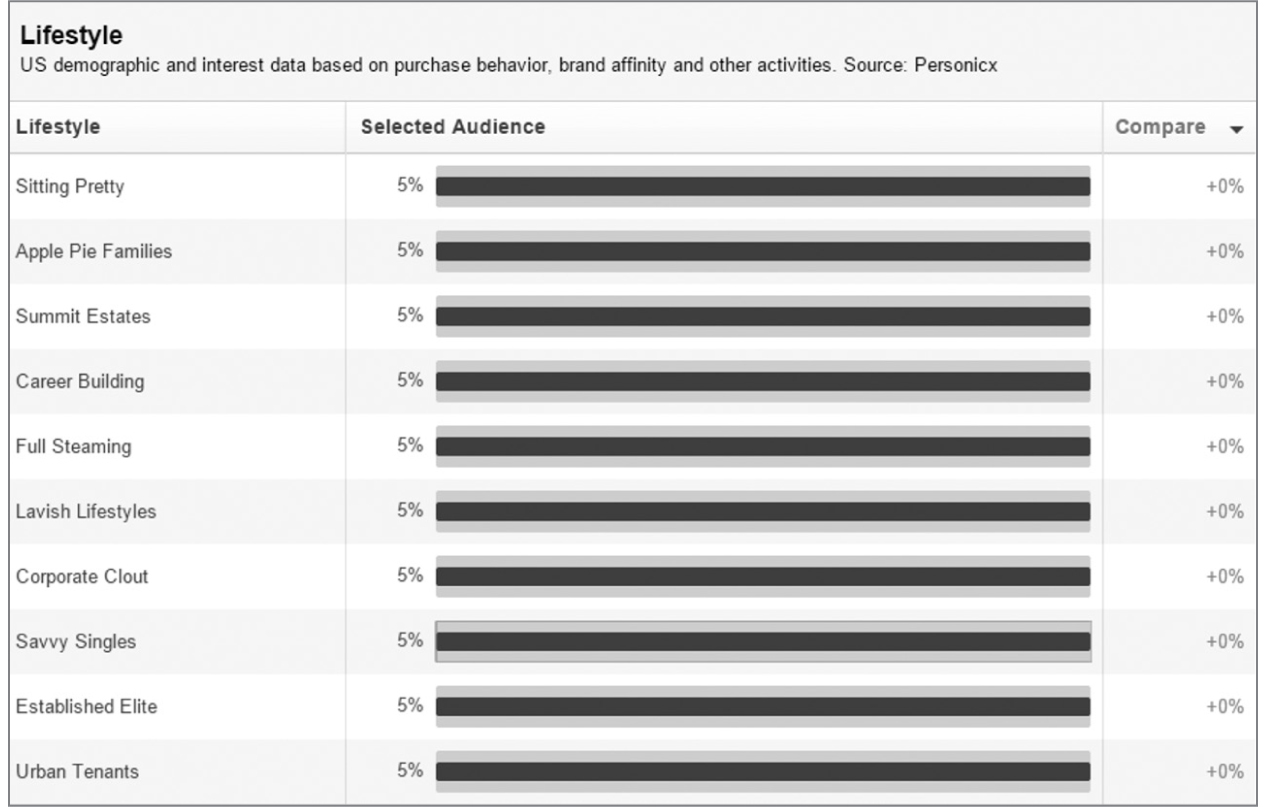
If we had looked at our client’s overall traffic and not its customers, our marketing focus would have been a lot different. By comparing what was different among the markets we could pinpoint characteristics of its most profitable prospect.
So how does this strategy all play out? We pinpointed the characteristics of the company’s members that were different than others and targeted those with our ads. Looking at those demographics, we saw that business travel ranked high. So we started to target a look-alike of its membership list plus American Airlines. These have produced subscriptions from cold traffic at a return 300% of the ad cost. These golden nuggets are where your real ROI comes in to play because your competitors will not target these hidden demographics. They will stay within the obvious competitors.
(For a how-to on how to use Facebook to access your customer demographic information, visit www.NoBSSocialMediaBook.com.)
Get More of Your Best CustomersGet More of Your Best Customers
by Kim Walsh-Phillips
Focusing on a certain few means creating raving fans who will pay you top dollar to meet their needs.
So how do you get started with diving deep into your best target market?
Look at your sales numbers, and choose from your top 10% of profitable customers. Get to know them better and focus your attention on getting more sales from them and attracting more people like them. Do not be enticed by the new trend, fad, or what pop culture is telling you. Focus on what is currently bringing you the most profit.
Unfortunately, so many businesses get this wrong.
Last year the Las Vegas big boy casinos lost over $1 billion, and several on the Atlantic City strip closed. How could this be?
Their attendance was up, their hotel stays were up, their nightclub business was up, restaurant and bar sales were up. How could their sales be down by $1 billion???
It is because they didn’t focus on their most profitable customers. It was their belief that new customers should be pursued. This attracted a lot more customers who were NOT PROFITABLE. These new Vegas, Atlantic City, and Reno fans sleep all day, party all night, and do not gamble. They don’t shop nor do they utilize the services and amenities of the buildings. They cannot come close to supporting the 55,000+-square-foot buildings that the nightclubs are housed in, even with their $250 per-night bar tabs.
The casinos became married to the idea that their money should be invested in attracting new younger, hipper, sexier customers, and they achieved that. What they failed to do was to invest in their current very profitable customers who were actually making them money.
Whether or not you support the philosophies of the casinos or Vegas as a whole, there is a lot to be learned from their catastrophic business failure. They were caught up in Shiny Object Syndrome (SOS) and the need to go after something new when their most profitable market was already right in front of them. If they had focused on getting to know their best customers better in order to serve them better, they would be in a far different situation now.
Judging from their Facebook marketing, this unprofitable way of thinking hasn’t changed. They feature images of food, pools, nightclubs, and parties.
Vegas’s submission to Shiny Object Syndrome now has casinos needing to send out an SOS of a monumentally different variety.
Survey Your Best CustomersSurvey Your Best Customers
by Kim Walsh-Phillips
When you know who your best customers are, your next step is to get to know them better.
Guessing is good.
Like when I am trying to help my kids pass the time in line to board the carousel at the mall, playing the “I spy” game (my youngest always guesses “pink” no matter what we are looking for). Or when I am putting a few dollars down on the roulette wheel when a speaking engagement takes me to Vegas. (I am not their target market, by the way. I much prefer a nightclub to a gambling table.)
Guessing is not good when it comes to marketing, especially when the answers are available to you.
When it comes to marketing, guessing is similar to baking a bad cake. There’s a recipe with all of the measurements and measuring cups next to you, but instead you just toss ingredients in a bowl. Sure there is a chance you’ll get it right, but it would have been better if you’d followed the recipe. And there’s a pretty good chance you’ll just screw up the whole thing.
Research is good. But it isn’t sexy. So most businesses skip it.
But research can be exciting. Seriously.
You can actually get leads while you are researching your target market. By sending out a simple one-question audience survey, you can gain amazing results that can influence your marketing and generate revenue.
Sample One-Question Surveys
• “What’s the number-one question you have about (xyz industry)?”
• “If you could change one thing about (xyz industry), what would it be?”
• “If you had a magic wand, what’s the one thing you would like to be different about (xyz industry or their pain or frustration)?”
The answers to these questions can provide you with the following results.
• Factual data about the likes, habits, hobbies, and needs of your target market. Effective marketing is based on facts, not guesses. Determining the needs of your target market through research will give you the greatest chance of success.
• A report you can use to get publicity. Once your survey is complete, release your findings to the media as a “State of the Industry” report. Done well, this will not only give you fantastic media coverage, but also establish you as “the expert” in your field to the media, making you the go-to choice for future stories.
• Provides a plethora of effective copy you can use in your marketing. When you ask your target market what they want to know more about in your industry, their answers come in their own words. This gives you the exact copy to use in your marketing and content development. This will not only resonate better with your audience, but will help your Search Engine Optimization—since you will write copy the way your audience will search for it. Also use this copy as subject lines in your emails, headlines in your social media ads, and the opening lines of your email campaigns.
• Hands you qualified leads (The money question!). Within the answers of your target market, you can find new customers, upsell opportunities from current customers, and identify referral sources and other business opportunities. The last time we ran this question, we found a treasure trove of responses, including speaking engagement offers, prospect interview requests, and referral opportunities.
A few tips on a seamless execution:
• Use the free resource SurveyMonkey to draft your question.
• Offer a prize to one lucky respondent or an incentive to each person, like an ebook, free report, or video.
• Distribute the survey through email, your blog, and/or social media channels.
• Give a deadline of only a week to take the survey.
• Review the results.
For a step-by-step how-to on the tech side of things, visit www.NoBSSocialMediaBook.com for a video tutorial.
We recently did a rather comprehensive survey about the social media marketing behaviors of businesses. We offered the significant incentive of a $997 video training. Of course, it cost me nothing, but the perception of value is all that matters to increase responses. Through this survey, we were able to discover our audience’s biggest frustrations, in their own words. I used respondents’ exact statements as the bullet points in a webinar following this project.
We also leveraged the survey to get PR for our firm, as a lead magnet, and as a special gift for our Marketing Insiders Elite Members.
And we got new clients out of it, generating the only important metric—profit.
Money, intel, and PR? That is a valuable process.
#NoBSsm Tweetable Takeaways#NoBSsm Tweetable Takeaways

![]() Steps to define your niche: Who is the specific buyer and why is what you are selling important to him? #NoBSsm
Steps to define your niche: Who is the specific buyer and why is what you are selling important to him? #NoBSsm

![]() It is much better to have 500 raving fans than 10,000 tepid followers. #NoBSsm
It is much better to have 500 raving fans than 10,000 tepid followers. #NoBSsm

![]() Look for golden nuggets in Facebook’s Audience Insights because your competitors will stay within the obvious. #NoBSsm
Look for golden nuggets in Facebook’s Audience Insights because your competitors will stay within the obvious. #NoBSsm

![]() Focusing on a certain few means creating raving fans who will pay you top dollar to meet their needs. #NoBSsm
Focusing on a certain few means creating raving fans who will pay you top dollar to meet their needs. #NoBSsm

![]() Guessing is not good when it comes to marketing, especially when the answers are available to you. #NoBSsm
Guessing is not good when it comes to marketing, especially when the answers are available to you. #NoBSsm